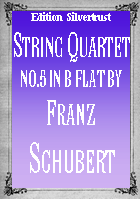Presents
Franz Schubert
 |
|
String Quartet No.5 in B flat Major, D.68
Franz Schubert (1797-1828), one of the most famous composers of all time, requires no introduction. However, his first six string quartets are virtually unknown and rarely heard let alone played. To learn more about their background and why that is Click Here.
Schubert finished the Fourth Quartet in early March 1813. He began work on String Quartet No.5 in B Flat Major, D.68 in mid June of that year. He worked on it for about a week and then put it aside. During the middle of that August, he took it up again and completed it. Like all of the first six quartets, it was not published until 1890. By this time, the two middle movements of the manuscript had either disappeared or disintegrated on printers shelves. They have never been found. The opening movement, a massive Allegro, is extraordinary from several standpoints. First, is its very sizeóat least twice as long as any other of his previous first movements. Schubert did not choose to write on this scale again until Quartet No.13. Next is the orchestral quality of the music. Schubertís use of pairs created a density of tonal sound which was without parallel and which often created a sound more like a small string orchestra then a quartet. The movement opens with all four voices playing a loud triple-stop half note. The rest of the phrase continues on in unison with a loud retort followed by a soft answer. After repeating this sequence, it is slightly altered and repeated again until the first violin finally begins the somewhat operatic main theme over the pulsing accompaniment in the other voices. It can be seen that this theme derived is in part from the unison introduction. The use of triplets in this movement is especially prominent and it is the way in which they are used that, perhaps more than any other feature, establishes the lineage between this work and his Symphony No.9, the Great C Major to which this work must be considered an antecedent. There are long stretches during this movement where the orchestral sound is created by the use of paired triplets. The overall sound is further enhanced because the second violin is belting out double stopped triplets. The effect is both unusual and quite striking. The finale, an Allegro, is also written on a larger scale than what he had heretofore composed. The catchy opening theme, at first blush, does not appear able to withstand extensive development, but Schubert surprises with a wealth of ideas.
Despite the fact that there are only 2 movements to this work, it is as long as his others and because of the new paths Schubert was blazing is well worth hearing in concert and at home. Again, we are not only pleased to offer this quartet but also Quartet Nos. 4-6 as a book at a special price.
| (A) String Quartet No.5-Parts | $24.95 |
|
|
(B) String Quartet No.5-Parts & Score |
$31.95 |
|
| (C) String Quartet Nos.4-6-Parts | $64.95 |
|
| (C) String Quartet Nos.4-6-Parts & Score | $84.95 |
|